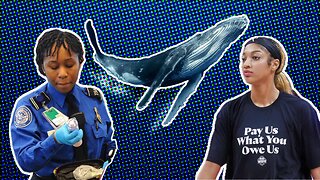Premium Only Content

Pandemic Apprentice: The Office Edition
EARLY INTELLIGENCE TIMELINE ON COVID-19
December 31, 2019: Known that only 15 cases of pneumonia of unknown etiology had been identified to be associated with Hunan Seafood Wholesale Market, with no fatalities, but it had already become international news.
January 10, 2020: First reported COVID-19 fatality, and even at that time, Chinese medical authorities had no evidence that the disease was being transmitted from person to person.
January 20, 2020: A study commissioned by the WHO had determined that South Korea, the closest geographic enemy of the People's Republic of China, was the 17th top destination from Wuhan Airport, but by February, Daegu, the location of the first active duty military infection, was the hottest hot spot in South Korea.
January 24, 2020: CNN published a story regarding a possible zoonotic source for the novel coronavirus: Chinese krait or king cobra, but any microbiologist or virologist knows that coronaviruses infect only mammals and birds, not reptiles.
February 24, 2020: The largest sample size trace contact study performed before the pandemic declaration had specifically found a secondary attack rate ranging between 0.9% and 4.8%, 12 times too low to be described as "highly contagious", and, hence, be capable of setting off a super spreader event, as was repeatedly alleged to have occurred, in a disease that presented a consistent pattern of clustered outbreaks with no wider community spread.
Yet, even by April 2020, Dr. Ralph Northam, a former U.S. Army surgeon, conceded that at no time did he ever, in an abundance of caution, conduct a review to determine whether the novel coronavirus had been cultivated or manipulated in a laboratory, and that he had never considered the possibility that even a highly contagious disease might have been weaponized.
-
 8:11
8:11
Millionaire Mentor
14 hours agoJohn James SHUTS DOWN AOC With One BRUTAL Sentence
42 -
 31:34
31:34
Friday Beers
13 hours ago $0.88 earnedOur Horrifying Night Drunk Ghost Hunting the Manson Murders
26.9K6 -
 4:09
4:09
Blackstone Griddles
12 hours agoEndless Summer Smashburgers on the Blackstone Griddle
1.42K1 -
 LIVE
LIVE
BEK TV
22 hours agoTrent Loos in the Morning 7/24/2025
430 watching -
 7:02
7:02
China Uncensored
14 hours agoWell, I Guess Now We Know...
2.79K15 -
 46:10
46:10
Members Club
17 hours agoThe WNBA Has Demands, TSA Loosens Up, and NYC Has a Whale Whisperer - MC04
1.17K -
 1:35:15
1:35:15
Man in America
14 hours ago🚨 ALERT: Hospitals in the U.S. Are KILLING Patients… for Their Organs!
73K31 -
 8:00
8:00
DropItLikeItsScott
14 hours agoIs This The BEST SIG P365? SIG P365 FUSE
1.12K -
 11:55
11:55
The Shannon Joy Show
13 hours ago🔥Babies Aborted for Cash.🔥
2.14K -
 6:24
6:24
Zach Humphries
14 hours agoBreaking Crypto News on Crypto Regulation!
3.92K2